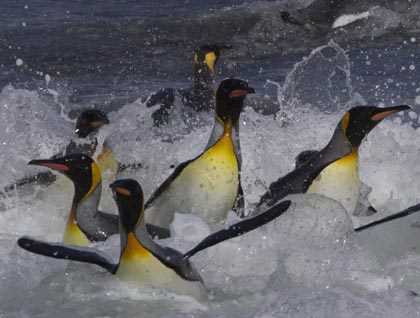There is a certain apprehension when your expedition leader tells you that for a second day in a row you will be starting your visit ashore at 4.30 a.m. (thanks for Lisa Standard Time!). Add to that the fact that we had been incredible lucky with the weather and sunrise the previous day and certainly we couldn’t count on topping that on a consecutive day, knowing the famous inclement weather conditions of South Georgia. Off to bed early and full of hope we went anyways, since the day had been long and intensive. Seemingly only a few minutes later, the voice on the PA system woke us up announcing that conditions were good for us to land at Gold Harbor, but it was wrong…
Conditions were in fact outstanding! Even the soon-to-die wind was from the ‘right’ direction, smothering the small breaking waves and allowing for an extremely easy landing. Within minutes, dozens of inquisitive and hungry elephant seal pups recently weaned surrounded our landing spot nibbling at anything they could find—including some of us. Sunrise covered us with a warm light that actually felt like a wash of gold and honored the name of this gorgeous site. What a display of life! Thousands of king penguins and hundreds of elephant seals dominated the beaches. On the tussock grass behind, a few gentoo penguins and some early fur seals in the beginning of their breeding season and in the slopes, the magnificent light-mantled albatross displayed and called from the ledges and small waterfalls tickled down the hillsides. Life has, of course, a side that may seem harsher or darker. A seemingly abandoned seal pup, dead on the beach, became a feast for over 60 giant petrels and brown skuas in a somehow gruesome yet natural show that enabled us to grasp a bit of how harsh and unforgiving life in these extreme latitudes can be.
Later in the afternoon, we ship cruised into the Drygalski Fjord, a spectacularly carved deep entrance in the southern end of the island, where mighty glaciers come down the steep hillsides painting an Himalayan landscape in the middle of the southern oceans, dotting the waters with bergs of all sizes. The Extreme Ice Survey team left us to retrieve the data from the cameras installed here the previous season, aiming to capture the life of some of these glaciers over a year period. Some 4500 pictures were happily found stored in the memory cards, much to the relief of the team. Meanwhile the National Geographic Explorer approached the main glacier at the end of the fjord for a close look and almost as if it had been previously organized, a couple of noisy calving events closed up our visit to this oasis of the southern oceans. But wait, there is more! Shortly after heading south we could see in the radar we had some serious pieces of ice ahead. One of them was a huge chunk of B17, a massive tabular berg that broke off on the Ross sea sector some 14 years ago and has been blown and carried by currents around Antarctica ever since. Thousands of seabirds were feeding on the nutrients the berg makes surface while corroding the bottom of the sea where it is grounded at the moment. Surely a grand end to a fantastic day. Bye-bye South Georgia, we sail to the sunset heading to Antarctica tonight. May the southern ocean gods be kind on us…!









